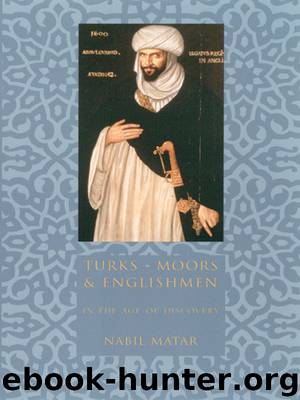Turks, Moors, and Englishmen in the Age of Discovery by Nabil Matar

Author:Nabil Matar
Language: eng
Format: epub
Tags: LIT004130, Literary Criticism/European/General, HIS026000, History/Middle East/General
Publisher: Columbia University Press
Published: 2008-10-24T16:00:00+00:00
5. “Iqleem Misr.” Courtesy of Professor E. Birnbaum (copyright holder), University of Toronto.
America was the Canaan or Palestine of the Western hemisphere. This “Canaan theme,” as Alfred A. Cave has called it,14 was so frequently invoked by colonists in the seventeenth century that it defined their ideological representation of America. In 1609, Robert Johnson assured the colonists that they would possess the new land in the same way that Caleb and Joshua had conquered the old Canaan. The colonists, preached Robert Gray in 1609, were to “conquer and cast out those Idolatrous Cananites, & to plant themselues in their places.” They were like the “ancient patriarchs,” wrote Robert Cushman in 1621, for whom it was “lawful now to take a land which none useth.”15 More than the French or the Spaniards, the English colonists viewed the American lands as the holy land that had been promised to the Israelites in Genesis. By turning the conquest of the land into a holy conquest that fulfilled typologically the Old Testament model in which the Canaanites had been made to disappear, they legitimated for themselves the marginalization and destruction of the Indians.
Inherent in the English discourse about the Indians, as well as the Muslims, were arguments that English thinkers either borrowed from the Spanish conquistadores or arrived at independently. The first argument centered on the fact that the lands of the Indians and the Muslims were devoid of people. Some travelers to North America and to North Africa and the Levant confirmed that the lands they traversed were “empty”—so much so that later writers who had never left their English or Scottish libraries agreed. Other travelers explained that the small population of those lands was idle and lazy, and did not cultivate the land. Because the land was empty and the people useless and uninterested in industry—in a treaty between the Massachusetts Indians and the bay colonists, the Indians agreed not to be “idle”16—it was legitimate for European Christians to conquer the idle population and possess the empty land. Because the land was a vacuum domicilium, and because the natives did not “enclose” their property, John Cotton concluded, as had numerous advocates of colonization from the 1620s on, that “where there is a vacant place, there is liberty for the son of Adam or Noah to come and inhabit.”17 Armed with this reasoning, it was not difficult for puritan writers to make a logical leap from a vacant land to a land made vacant by the agents of God, who were commissioned by God to drive the indolent natives out or destroy them altogether. “Thus,” wrote John Mason after massacring the Pequots in 1637, “the Lord was pleased to smite our Enemies in the hinder Parts, and to give us their Land for an Inheritance.”18 God gave the new Canaan to the English in the same way He had given the old Canaan to the Israelites.
This argument for justifying the appropriation of native American lands was repeated in the context of Muslim lands.
Download
This site does not store any files on its server. We only index and link to content provided by other sites. Please contact the content providers to delete copyright contents if any and email us, we'll remove relevant links or contents immediately.
| African | Asian |
| Australian & Oceanian | Canadian |
| Caribbean & Latin American | European |
| Jewish | Middle Eastern |
| Russian | United States |
4 3 2 1: A Novel by Paul Auster(12283)
The handmaid's tale by Margaret Atwood(7679)
Giovanni's Room by James Baldwin(7191)
Asking the Right Questions: A Guide to Critical Thinking by M. Neil Browne & Stuart M. Keeley(5633)
Big Magic: Creative Living Beyond Fear by Elizabeth Gilbert(5610)
Ego Is the Enemy by Ryan Holiday(5294)
The Body: A Guide for Occupants by Bill Bryson(4974)
On Writing A Memoir of the Craft by Stephen King(4863)
Ken Follett - World without end by Ken Follett(4645)
Adulting by Kelly Williams Brown(4487)
Bluets by Maggie Nelson(4473)
Eat That Frog! by Brian Tracy(4435)
Guilty Pleasures by Laurell K Hamilton(4360)
The Poetry of Pablo Neruda by Pablo Neruda(4039)
Alive: The Story of the Andes Survivors by Piers Paul Read(3968)
White Noise - A Novel by Don DeLillo(3954)
Fingerprints of the Gods by Graham Hancock(3940)
The Book of Joy by Dalai Lama(3899)
The Bookshop by Penelope Fitzgerald(3775)
